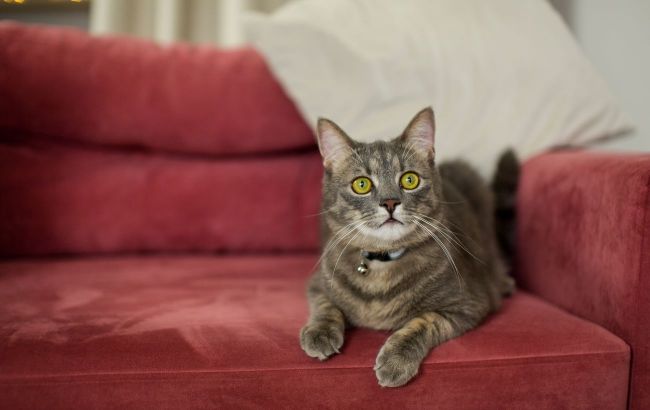Why cat follows you or shows belly: Guide to understanding your pet
 How to decipher a cat's behavior (Photo: freepik.com)
How to decipher a cat's behavior (Photo: freepik.com)
Analyzing a cat's behavior for an experienced owner is not difficult, especially since these animals clearly indicate their likes and dislikes through their behavior. However, sometimes the behavior of cats can puzzle and perplex their owners. This material discusses why a cat follows you with its tail up, not taking its eyes off you, and how to decipher other wonders of the fluffy creature.
During the preparation of the material, sources such as Animal Hospital, Rawz, and All about cats were used.
Why a cat follows you
Felinologists identify several reasons for such behavior in a cat:
-
The cat is afraid of being separated from the owner. It doesn't want to be left alone at home and may refuse to eat when left by itself. This behavior can be accompanied by problems with using the litter box - the cat may relieve itself in inappropriate places, such as near the entrance doors or the owner's belongings.
-
The cat wants to eat, drink, or is requesting the litter box to be cleaned. By following you, the cat is signaling that it needs something from you. Make sure the food and water bowls are full, and the litter box is cleaned promptly.
-
The cat is in pain. This behavior may be a way for the cat to communicate that it needs help, either from you or a veterinarian. If such behavior is present along with a refusal to eat and other abnormalities, consult a professional.
-
The cat is bored. When there's no owner at home, the cat may not know how to occupy itself. This is especially true for indoor cats who can't hunt and may feel lonely. Provide soft sleeping spots and toys to keep the cat entertained.
-
Lack of attention. The cat is craving interaction with the owner, playtime, attention, and affection. On average, a cat needs about half an hour of your time each day for talking, playing, or simply petting.
Basics of cat body language
Relaxed cat:
-
Tail gently swaying
-
Relaxed head
-
Relaxed ears
-
Relaxed mouth
-
Purring
Frightened cat:
-
Fur on the back standing up
-
Stiff tail
-
Arched back
-
Ears pulled back
-
Wrinkled nose
Angry cat:
-
Tail twitching or lashing
-
Straight back
-
Ears pinned back
-
Whiskers forward
-
Growling
-
Hissing
-
Various menacing sounds
How to distinguish sounds
-
Meow: A universal word that can be a greeting, a command (want to go up, go down, give food, open the door), a refusal (don't touch me), or an announcement (here's your mouse). Some cats may meow just while walking around the house.
-
Chirping and trilling: Typically how cats communicate with their offspring and each other.
-
Purring: An expression of contentment. Cats purr when they are comfortable, safe, and happy. They may purr even while eating. Sometimes, cats purr when they are anxious or in pain, as a way to comfort themselves.
-
Growling, hissing: Indicates a cat is irritated, frightened, angry, or aggressive. It's best to leave them alone.
-
Yowling: Loud and prolonged yowling. Your cat needs immediate attention, as it might be stuck, injured, or in pain. In unsterilized cats, yowling can be part of mating behavior. Older cats may yowl due to dementia and disorientation. Intense yowling usually signals distress.
-
Chattering or chirping: Sounds cats make when sitting by a window and watching birds. Usually a sign of a desire to hunt.
Cat Habits
-
Rubbing: When a cat rubs against you with its chin or its entire body, it's expressing its feelings. In reality, the cat is marking its territory. It does the same by rubbing against furniture, doors, its toys, and things it likes. This is its way of letting everyone know that these are its belongings, including you. It's a sign of affection towards you.
-
Kneading: When a cat kneads with its paws, it's a behavior from early kittenhood when kittens massage their mother's nipples to stimulate milk flow. If an adult cat does it, don't worry; it's just feeling really comfortable.
-
Exposing the belly: The stomach is the most vulnerable part of a cat, so if it exposes its belly to you, it means it feels safe. If it happens during play, be cautious; it's a "cat trap," and as soon as you reach out, claws might come into play.
-
Bringing "gifts": Whether it's a toy mouse or a real one, your sock stolen from the closet - when a cat brings you gifts, it's telling you it's a great hunter and can provide for you. Be grateful for these offerings.
-
Biting or nipping: Licking or gentle biting is a manifestation of affection. Ensure that these love bites don't cause harm, and if your pet bites too hard, let it know that it's unacceptable.
Earlier, it was reported that geneticists had revealed how dogs would look in 10,000 years.

